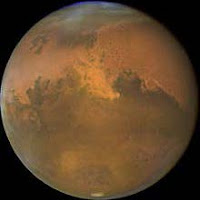Icebreaker field team arrives in New Zealand
- Credit:| by Brian Glass
-
Are there organic compounds or signs of past or present life on Mars? The top meter is dry and irradiated. But we have still only dug (with Phoenix in 2007) about 20cm, and the small drill on the Curiosity rover is only 5cm long. It is the Mars subsurface, of a meter or more deep, where we expect to find any preserved life-signatures and past climate history. So, we need a drill that can retrieve material at depths of 1m or more. Given the lightspeed time delays, a drill on Mars must be autonomous, very different from how drilling is done on Earth.
“Icebreaker” mission
The “Icebreaker” mission concept is to return to Mars to an area with subsurface ice layers in the first 1m depth, either at the polar latitudes (first visited by the Phoenix mission in 2007-08) or mid-latitudes (Viking). The Icebreaker payload could be mounted on a modified Phoenix spacecraft bus or on a rover, and carry an automated 1m rotary-percussive drill, the SOLID life-detection instrument, an Alpha Particle X-Ray Spectrometer (APXS) and JPL’s Wet Chemistry Lab, together capable of detecting organics in the presence of perchlorates or other strong oxidants. The automated Icebreaker drill captures downhole materials in the bottom 10cm of its drill string and raises these to the surface where they are mechanically removed and transferred to on-deck instruments.
Artist's concept of the Icebreaker drill and sample transfer system, mounted on a Phoenix-derived Mars lander platform.
Mars Lander Platform - Icebreaker Drill
Planetary drilling and sampling beyond the Moon requires intelligent and autonomous systems. Unlike terrestrial drills, the Icebreaker drill will work without injected drilling muds or lubricants, blind (with no prior local or regional seismic or other surveys beyond Phoenix’s excavations), and weak (very low [200N] downward force or weight on bit, and perhaps 100W power available). Given the 7-20 minute lightspeed transmission delays to Mars, while drilling faults manifest in terms of seconds, the Icebreaker drill cannot be controlled directly from Earth. Therefore highly reliable automated operations will be necessary, with the ability to safe the drilling system and recover from almost any downhole fault condition on its own.
Phoenix Mission and Spacecraft
The Phoenix arm was able to reach and scrape the ground ice but was unable to penetrate it significantly. Sampling deeper into the ground ice to acquire materials deposited during warmer climates requires a drill. The Icebreaker drill was designed and built by Honeybee Robotics. We have tested both rotary-drag and rotary-percussive drill designs in laboratory chamber tests and in field tests at Mars analog sites These have been in turn used to validate and test the controls and drill health management software necessary for Icebreaker automated drilling and sampling operations.Over the past four years, our Icebreaker team has developed the rotary-percussive drill hardware, the automated controls for the drill, and integrated these with a sample-transfer arm to instruments on a mockup spacecraft deck. A dry run in at Haughton Crater in the Canadian Arctic in July 2012 showed that these could work together to acquire and convey subsurface samples to on-board instruments for analysis.The technology objective of this field season is to repeat these integrated tests in a higher-fidelity, more difficult Mars analog site, in the Dry Valleys of Antarctica, and to continue to improve the reliability and fault-tolerance of the whole drilling and sample acquisition system.
Download PDF Transcript of Video
NASA Astrobiology
NASA’s Astrobiology Science and Technology for Exploring Planets (ASTEP) program supports investigations that focus on exploring Earth’s extreme environments to learn how best to search for life on other planets. A related effort called the Astrobiology Science and Technology Instrument Development (ASTID) program supports the development and testing of new technologies to enable the search for life outside Earth’s biosphere. Icebreaker is an umbrella project supported by both ASTEP and ASTID to both develop sample-acquisition technologies and incorporate these in investigations in extreme environments.
 |
| Martian Soil Secrets |
This field season, our team of seven will be comprised of three NASA Ames researchers (Alfonso Davila, Margarita Marinova, and myself), a Honeybee Robotics drill engineer (Bolek Mellerowicz), two university co-investigators (Wayne Pollard of McGill University, Denis Lacelle of the University of Ottawa) and a graduate student (Jacqueline Goordial of McGill University).
McMurdo Station, Antarctic
Alfonso Davila departed for Antarctica in December and has been at McMurdo Station for a couple of weeks, serving as our advance liaison there. The rest of the team departed North America on 29 December 2012 and are now in Christchurch, New Zealand waiting for weather and aircraft availability for the next leg down to McMurdo. We have been told that the ice runway at McMurdo Station has been too warm – hence mushy – for aircraft to depart to return to the Antarctic deployment center at Christchurch, New Zealand, So we have had to wait several days longer than expected in Christchurch (which locals abbreviate as “Chch”).
